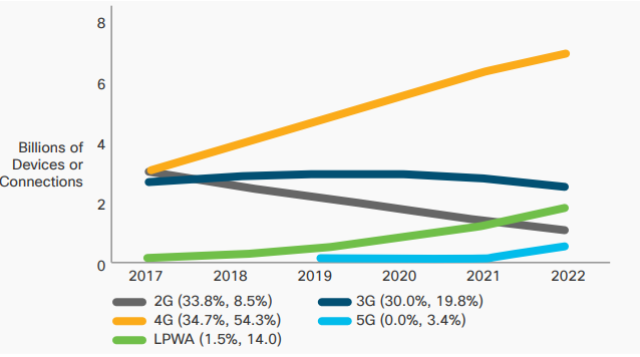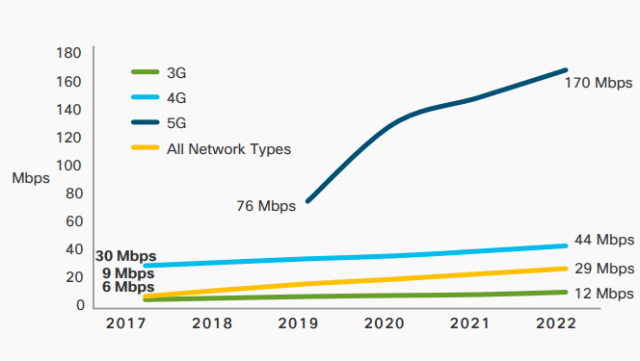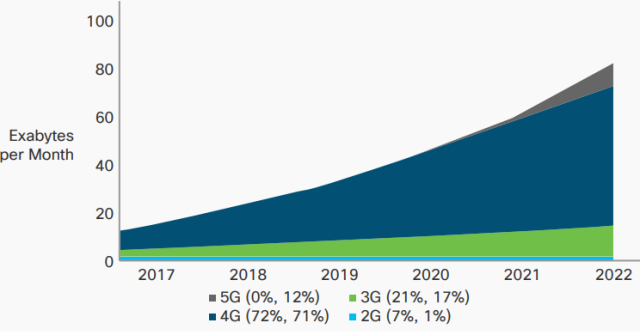Cisco today released the Mobile Visual Networking Index (VNI) forecast — indicating how 5G will bring revenue to telecom operators, smartphone companies, chipset firms and mobile equipment makers.

5G traffic will be 12 percent of the total mobile traffic by 2022. This indicates several mobile operators will be investing in 5G networks to manage the traffic.
5G will be 3.4 percent of connections but 11.8 percent of total traffic. A 5G connection will generate 2.6 times more traffic than the average 4G connection. Customers will be looking for 5G devices and smartphones to benefit from the new experience. There will be 3.4 percent devices and connections with 5G capability.
4G connections will be 54.3 percent of total mobile connections, compared to 34.7 percent in 2017. The mobile 4G connections will grow from 3 billion in 2017 to 6.7 billion by 2022 at a CAGR of 18 percent.
5G connections will appear on the scene in 2019 and will grow several thousand percent from under half a million in 2019 to over 400 million by 2022.
Mobile devices and connections in Western Europe (58 percent), Latin America (58 percent), Asia Pacific (61 percent) as well as Central and Eastern Europe (63 percent) will have 4G+ capability, surpassing 3G-capable devices and connections.
 North America will have 51 percent of 4G+ connections by 2022. Middle East and Africa at 54 percent will have the highest share of its devices and connections on 3G by 2022. North America with 37 percent and Western Europe with 27 percent share will be the two regions with highest LPWA adoption.
North America will have 51 percent of 4G+ connections by 2022. Middle East and Africa at 54 percent will have the highest share of its devices and connections on 3G by 2022. North America with 37 percent and Western Europe with 27 percent share will be the two regions with highest LPWA adoption.
North America will be the region with highest share of connections on 5G at 9 percent. The top three 5G countries in terms of percent of devices and connections share on 5G will be Japan (12 percent), Sweden (11 percent) and United States (10 percent).
Smartphone customers will be moving to 5G network in a big way from 2022 putting new pressure on telecom networks. But mobile operators will be in a position to improve their ARPU. Cisco report did not mention about the impact of traffic or connections on the ARPU of 5G smartphone customers.
4G carried 72 percent of the total mobile traffic in 2017. 4G share will go down slightly to 71 percent of all mobile data traffic by 2022. 5G will support 12 percent of mobile traffic. 5G connectivity with its very high bandwidth (100 Mbps) and ultra low latency (1 millisecond) is expected to drive very high traffic volumes.
Currently, a 4G connection generates about three times more traffic than a 3G connection. The average 5G connection will generate nearly 3 times more traffic than the average 4G connection.

The amount of traffic offloaded from 4G was 57 percent in 2017, and it will be 59 percent by 2022. The amount of traffic offloaded from 3G will be 40 percent by 2022, and the amount of traffic offloaded from 2G will be 30 percent.
The offload percentage on 5G is estimated to be 71 percent by 2022.
Total public Wi-Fi hotspots including homespots will grow 4-fold from 2017 to 2022, from 124 million in 2017 to 549 million by 2022. Total Wi-Fi homespots will grow from 115 million in 2017 to 532 million by 2022.
4G speeds will be nearly double than that of an average mobile connection in 2022. Average 5G speeds will increase from 76 Mbps in 2019 to 170 Mbps by 2022. 5G is expected to be in its infancy by 2022, globally, 5G connections will be 3.4 percent of total mobile connections, Cisco said.
Baburajan K





